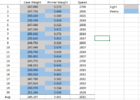Hi all,
Without giving away the components, I was hoping someone with some excel skills could help me analyze the raw data attached (raw excel file attached along with pic of data). I took a box of brass and a box of primers and weighed each on my Sartorius scale. I selected the 10 heaviest and 10 lightest of each and loaded them using my regular load development and fired them over my Magnetospeed.
5 heavy cases matched with 5 heavy primers
5 heavy cases matched with 5 light primers
5 light cases matched with 5 heavy primers
5 light cases matched with 5 light primers

I know this is a very small sample set, but is there anything to conclude from the data?
Best,
Without giving away the components, I was hoping someone with some excel skills could help me analyze the raw data attached (raw excel file attached along with pic of data). I took a box of brass and a box of primers and weighed each on my Sartorius scale. I selected the 10 heaviest and 10 lightest of each and loaded them using my regular load development and fired them over my Magnetospeed.
5 heavy cases matched with 5 heavy primers
5 heavy cases matched with 5 light primers
5 light cases matched with 5 heavy primers
5 light cases matched with 5 light primers

I know this is a very small sample set, but is there anything to conclude from the data?
Best,
Attachments
Last edited:










